Cypriot Cuisine Is One Of The Highlights Of Visiting The Island
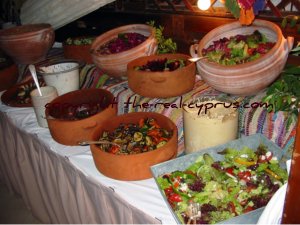
It has been said by many about Cypriot cuisine and the local cheese in particular and I can see why...
| A cypriot house without some homemade halloumi in the fridge is like a church without a crucifix |
.. and actually I get that, Cyprus food is almost a religious experience for the families of the island.
Food shows love, food shows hospitality, food shows the history of the island on plate.
Hospitality is inbuilt in the psyche of the cypriot people and they have a word they use, KOPIASTE.
| Kopiaste in Greek means: Come & enjoy our hospitality! |
Over thousands of years, french, italian, arabic, turkish and british influences have turned up in one recipe or another.
So What Is The Cypriot Cuisine All About?
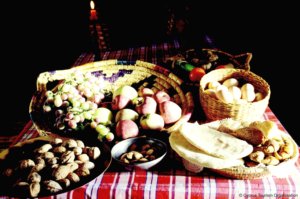
The traditional diet in Cyprus is very healthy, in much the same way as the rest of the mediterranean area.
Vegetables, salad, pulses fruit, olive oil, bread and small amounts of meat, although sometimes I think the "small amounts of meat" is debatable when you come to experience a meze.
Even the fast food, and I don't mean Macdonalds, is pretty healthy, pitta bread with freshly chargrilled meat and salad and a dash of fresh lemon is delicious, quick and relatively cheap, and it fills you up nicely.
The basics of cypriot cuisine have been around since John the Baptist was in the wilderness, olives, figs, dates, honey, almonds, beans and chickpeas.
It is said that the carobs, which are prolific in Cyprus in Anogyra Village were actually what people meant when John had locusts to eat in the desert. How true this is no-one knows but it sounds like a good story!
Traditional Cyprus Food
Cheese
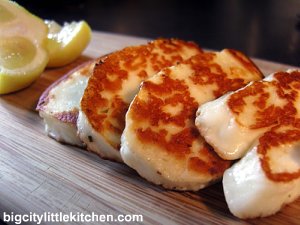 The most well known, and by well known, I mean it is found outside of Cyprus and used on TV in cookery shows is
Halloumi Cheese
This is eaten, fried or grilled (especially on the barbecue), and amazing eaten uncooked with fresh watermelon, or just in a salad.
The most well known, and by well known, I mean it is found outside of Cyprus and used on TV in cookery shows is
Halloumi Cheese
This is eaten, fried or grilled (especially on the barbecue), and amazing eaten uncooked with fresh watermelon, or just in a salad.
Made with a mixture of sheeps and goats milk in a cauldron, rennet is added, the heat is turned off and the curds are scooped up, squeezed, put in a mould and pressed.
The moulds are then turned out and cooked again in the whey previously left over and when the cheese rises, it is taken out and dried mint is added with a bit of salt, folded over and stored in the cooled whey liquid, you will see this all over Cyprus, and in peoples homes, and quite a lot of the time, it is not in the fridge but it is safe to eat as the salt preserves it.
What is left after the production of halloumi is made into ANARI a softer cheese which is like Ricotta, so nothing is wasted. You will find it in a local pastry called BOUREKIA. I highly recommend you give them a try from the bakery.
Bread
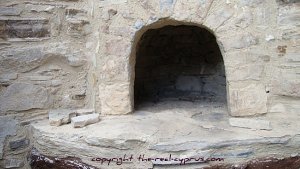
The smell of bread the world over, is delicious and heartwarming. Cyprus village bread is the local bread and is something you should try.
You can buy sliced bread and regular bread as well, and what you will find is it is always freshly baked.
You will notice when you visit, the bakeries are all open from very early until very late, about 10 or 11 pm.
There is a rule in Cyprus about the bakeries, and it is they must always be open and available for people to buy bread during waking hours, so if nothing else available, there will always be bread on offer so a family can be sure to have something to eat.
I think it may go back to 1974 when food became a problem at times.
Top Tip
The bread does not stay fresh by day 2, it is lack of preservatives, so we like to toast it for breakfast and this will let you get a bit more "life" out of it.
Another great way of eating local village bread is to brush it lightly with some olive oil and a bit of salt and then bbq the bread, or in the absence of a bbq use a grill pan so you get the authentic grill lines on it. Absolutely delicious as a change from pitta bread, but do go lightly on the oil and salt!
Carob
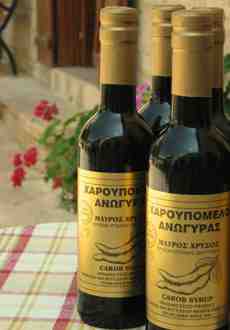 Carob is synonymous in Cypriot Cuisine and the village of Anogyra as mentioned above, when you visit the area you will see nothing but Carob trees.
Carob is synonymous in Cypriot Cuisine and the village of Anogyra as mentioned above, when you visit the area you will see nothing but Carob trees.
Known for being Black Gold, the charoupomelo is made by boiling the ripe pods from the trees and mashing them and straining the mix and then reducing it to the consistency of honey.
Pasteli the local sweetmeat is made with the syrup and I highly recommend you try some.
It can taste a bit like bonfire toffee depending on where it has been made, if you purchase it in the village you can be sure it is the original thing. Other companies make it but it can have a different flavour. You can also buy carob syrup in bottles and take them home to use in your cooking.
Olives In Cypriot Cuisine
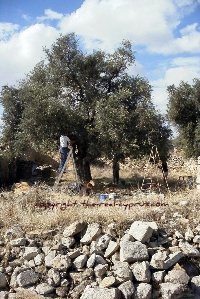
Olives are as synonymous with cypriot cuisine as cheese is to french cooking. The two just go together.
Many cypriot families have at least one olive tree to call their own and quite often they have a number of trees that have been growing for a very long time, set on a piece of family land, somewhere, to ensure they have adequate supplies for their needs throughout the year.
You will no doubt find the same families under those trees during high days and holidays, barbecuing and having a great time, or just on a summer sunday.
The green olive picking starts towards late autumn and they are either pressed or used to create the traditional cyprus cypriot cuisine recipe of cracked olives.
This is a unique dish to Cyprus, the olives are cracked and dried coriander seeds are crushed along with chopped garlic and dressed with fresh lemon juice and olive oil.
They make great appetisers with drinks and you will often get them as part of your meze, or just along with whatever local food you are eating in a restaurant.
Don't expect them in the chinese though!
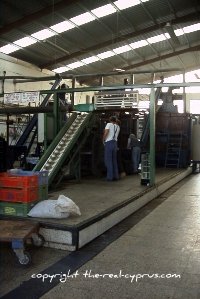 Later in the year, after the green olives, come the black olive harvest....(black olives are green olives left longer on the tree, not another type of olive, I never knew that for a very long time.. lol!)
Later in the year, after the green olives, come the black olive harvest....(black olives are green olives left longer on the tree, not another type of olive, I never knew that for a very long time.. lol!)
This photograph was taken at the Erimi Village Olive Press, after a hard days olive picking in Souni (above), a village on the road up to Troodos on the west side of Limassol, we wanted an authentic cypriot cuisine experience.
Each person takes up their olives, and you can press a small amount or a large amount, whatever you have, and your pile goes into a container and travels up the conveyor belt to the top where they are emptied into the press and they are mechanically squeezed.
You have to wait at the end of the press, holding your plastic container, bottle or whatever you have brought and you collect your very own freshly pressed olive oil.
There is nothing quite like collecting your own oil, I imagine you would get the same feeling if you grew your own grapes and produced your own wine.
The Kafenion - (The Coffee Shop)
The Coffee Shop - A Pillar In Cypriot Cuisine
Halloumi Recipes
Flaounes At Easter
Leave Cypriot Cuisine To Go To Home Page
Related Pages






New! Comments
Have your say about what you just read! Leave me a comment in the box below.